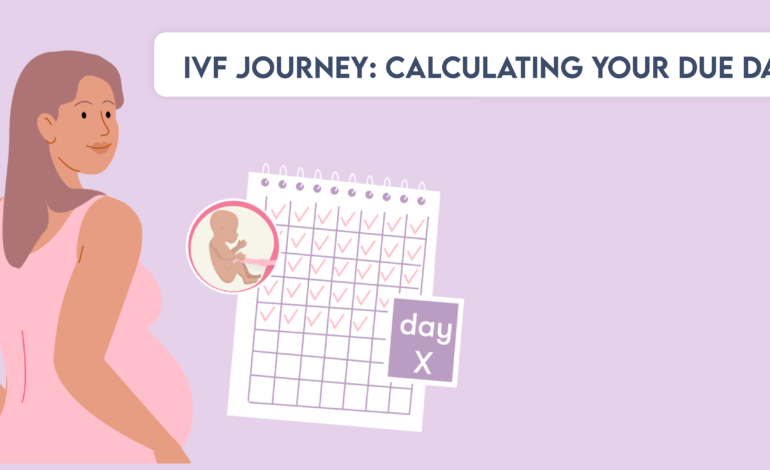Introduction
In the pregnancy journey, one of the most anticipated milestones for expectant parents is the due date — the estimated date when their baby will enter the world. Understanding your baby’s arrival timeline goes beyond simply marking a date on the calendar; it involves delving into the complexities of pregnancy, including the natural variations in delivery times and the factors that influence them. In this article, we’ll explore the concept of due dates, discuss the natural variations in delivery times, and explore the specific considerations for calculating due dates in IVF pregnancies.
The Concept of Due Dates
What Are Due Dates?
Due dates, also known as estimated delivery dates (EDDs), are calculated based on the first day of a woman’s last menstrual period (LMP) and the average length of a menstrual cycle, typically around 28 days. It serves as a reference point for healthcare providers to monitor the progress of pregnancy and plan for childbirth.
How Are Due Dates Calculated?
While due dates provide a framework for expecting parents, it’s essential to understand that they are estimates rather than guarantees. The calculation of due dates takes into account natural variations in delivery times and factors that may influence the timing of birth. These factors include maternal health, fetal development, and environmental influences.
Importance of Due Dates in Pregnancy
Due dates play a crucial role in pregnancy management, guiding prenatal care and helping healthcare providers identify any deviations from the expected timeline. They also serve as a focal point for expectant parents, marking the culmination of their pregnancy journey and the beginning of parenthood.
Natural Variations in Delivery Times
Understanding the Normal Range of Delivery Dates
While the due date marks the midpoint of a typical 40-week pregnancy, it’s important to recognize that delivery times can vary widely among women. The normal range for delivery spans from 37 to 42 weeks gestation, with most babies arriving between 38 and 42 weeks.
Factors Affecting Variations in Delivery Times
Maternal Factors
- Age: Advanced maternal age (over 35) or young maternal age (under 20) may influence the timing of birth.
- Health Conditions: Certain medical conditions, such as diabetes or hypertension, can impact pregnancy duration.
- Previous Pregnancy History: Women who have previously experienced preterm or post-term births may have a higher likelihood of recurrence.
Fetal Factors
- Size: Fetal growth and development play a role in determining when a baby is ready for birth.
- Position: The baby’s position in the womb, such as breech or transverse, may affect the timing of delivery.
- Health: Fetal well-being and health status can influence the initiation of labor.
Environmental Factors
- Stress: High levels of stress or emotional upheaval may trigger early labor or delay childbirth.
- Lifestyle Choices: Factors such as smoking, substance abuse, or inadequate prenatal care can impact pregnancy duration.
- Support System: Adequate social support and access to healthcare resources can contribute to a smoother pregnancy journey.
Factors Influencing Baby’s Arrival
Maternal Factors
Age
Age plays a significant role in pregnancy duration, with both advanced maternal age and young maternal age associated with increased risks of preterm or post-term birth.
Health Conditions
Certain medical conditions, such as diabetes, hypertension, or thyroid disorders, can affect the timing of birth and may require closer monitoring by healthcare providers.
Previous Pregnancy History
Women who have previously experienced preterm or post-term births may be at higher risk for recurrence and may require additional interventions or monitoring during subsequent pregnancies.
Read also Countdown to Cuddles with Our Week Calculator
Fetal Factors
Size
Fetal growth and development influence when a baby is ready for birth, with smaller or larger-than-average babies potentially affecting the timing of delivery.
Position
The baby’s position in the womb, particularly if they are in a breech or transverse position, may necessitate interventions such as external cephalic version or cesarean delivery.
Health
The overall health and well-being of the fetus, including any underlying medical conditions or abnormalities, can impact the timing of birth and may require specialized care.
Environmental Factors
Stress
High levels of stress or anxiety can trigger the onset of labor or delay childbirth, emphasizing the importance of managing stress during pregnancy.
Lifestyle Choices
Factors such as smoking, substance abuse, or poor nutrition can influence pregnancy duration and may increase the risk of preterm birth or complications during labor.
Support System
Having a strong support system, including access to viksoncare resources and emotional support from family and friends, can contribute to a positive pregnancy experience and may help mitigate potential risks.
Due Date Calculation for IVF Pregnancies
Overview of In Vitro Fertilization (IVF)
In vitro fertilization (IVF) is a fertility treatment that involves fertilizing an egg with sperm outside the body, typically in a laboratory setting. IVF may be recommended for couples struggling with infertility or those undergoing assisted reproductive technologies (ART).
How Due Dates are Determined in IVF Pregnancies
Due dates for IVF pregnancies are typically calculated based on the date of embryo transfer, rather than the date of the woman’s last menstrual period. This approach accounts for the precise timing of conception and allows for more accurate estimation of the gestational age.
Factors Specific to IVF That Influence Due Dates
Embryo Transfer Date
The date of embryo transfer serves as the starting point for calculating due dates in IVF pregnancies, with the embryo’s age at transfer considered when estimating gestational age.
Developmental Milestones
IVF pregnancies may progress differently than natural pregnancies, and factors such as embryo quality and developmental milestones can influence the timing of birth.
Understanding Your Baby’s Arrival Timeline
Communicating with Healthcare Providers
Open communication with healthcare providers is essential for understanding your baby’s arrival timeline, including discussing any concerns or questions about due dates and pregnancy duration.
Being Prepared for Variations in Delivery Times
Expectant parents should be prepared for the possibility of variations in delivery times and understand that the due date is an estimate rather than a guarantee.
Importance of Flexibility in Birth Plans
Maintaining flexibility in birth plans allows for adjustments based on individual circumstances and ensures a positive childbirth experience, regardless of deviations from the expected timeline.
Conclusion
Understanding your baby’s arrival timeline goes beyond simply knowing a due date; it involves recognizing the natural variations in delivery times and the factors that influence them. Whether you’re counting down the weeks until your due date or navigating the complexities of IVF pregnancy, being informed and prepared can help you embrace the journey of parenthood with confidence. Remember to communicate openly with your healthcare providers, be prepared for variations in delivery times, and maintain flexibility in your birth plans. By understanding your baby’s arrival timeline, you can embark on this exciting journey with knowledge and empowerment.



1 Comment
[…] is the key to navigating this journey with confidence, ensuring that you are prepared for the baby’s arrival timeline in every way possible. In this comprehensive guide, we’ll walk you through everything you need […]
Comments are closed.